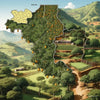
Here's a brief history of Kesar mangoes
Ancient Origins
Mangoes have been cultivated in India for over 4,000 years, with evidence of mango cultivation dating back to the Indus Valley Civilization (3300-1300 BCE). The Kesar mango is believed to have originated in the Girnar hills of Gujarat, India.
Mughal Era (1526-1756 CE)
During the Mughal era, mangoes became a prized fruit in Indian cuisine. The Mughal emperors, particularly Akbar and Jahangir, were known to be fond of mangoes and encouraged their cultivation in various parts of India. The Kesar mango is believed to have been introduced to the royal courts of Gujarat during this period.
Nawabs of Junagadh (1735-1948 CE)
The Nawabs of Junagadh, a princely state in Gujarat, played a significant role in popularizing the Kesar mango. They encouraged the cultivation of Kesar mangoes in their kingdom and exported them to other parts of India. The Nawabs also developed new varieties of Kesar mangoes, which further increased their popularity.
British Era (1858-1947 CE)
During the British era, the Kesar mango gained popularity in other parts of India, particularly in Bombay (now Mumbai) and Calcutta (now Kolkata). The British encouraged the export of Kesar mangoes to other parts of the world, which helped to establish the fruit's reputation as a premium variety.
Post-Independence (1947 CE onwards)
After India gained independence, the Kesar mango continued to grow in popularity. The Indian government established various programs to promote the cultivation and export of Kesar mangoes, which helped to increase their availability and accessibility.
Present Day
Today, Kesar mangoes are one of the most prized varieties of mangoes in India, known for their unique flavor, texture, and aroma. They are cultivated in several states, including Gujarat, Maharashtra, and Uttar Pradesh, and are exported to various countries around the world.
Overall, the history of Kesar mangoes is a rich and fascinating one, reflecting the cultural, economic, and culinary significance of this beloved fruit.


